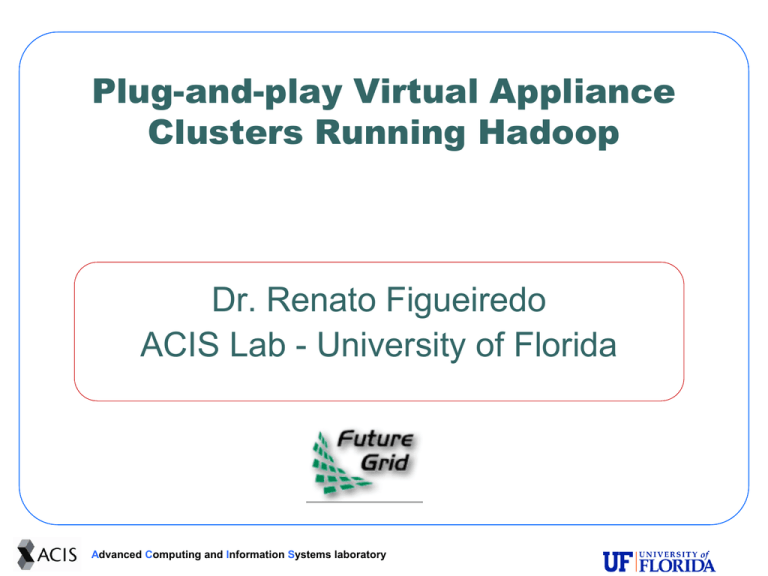Plug-and-play Virtual Appliance Clusters Running Hadoop Dr. Renato Figueiredo
advertisement

Plug-and-play Virtual Appliance Clusters Running Hadoop Dr. Renato Figueiredo ACIS Lab - University of Florida Advanced Computing and Information Systems laboratory Introduction You have so far learned about how to use Hadoop clusters Up to now, you have used resources configured by others In this lecture you will learn about ways of deploying your own software stack using virtual appliances And we will overview a system that makes for simple configuration of groups of virtual appliances – i.e. virtual clusters Advanced Computing and Information Systems laboratory 2 Objectives Concepts you will learn: Demonstrations, software that you will be able to take and follow on your own • What is a virtual appliance? • What is a GroupVPN? • What is a virtual cluster? • Deploy your Hadoop cluster (and beyond) • On clouds – e.g. FutureGrid, EC2, private cloud • On your own local resources – desktops • Even across institutions Advanced Computing and Information Systems laboratory 3 Outline Virtual appliances and the Grid appliance GroupVPN – easy to use, social VPNs Case study and demonstration: creating your own Hadoop cluster • Local resources • Cloud resources • Across providers Advanced Computing and Information Systems laboratory 4 What is an appliance? Physical appliances • Webster – “an instrument or device designed for a particular use or function” Advanced Computing and Information Systems laboratory 5 What is an appliance? Hardware/software appliances • TV receiver + computer + hard disk + Linux + user interface • Computer + network interfaces + FreeBSD + user interface Advanced Computing and Information Systems laboratory 6 What is a virtual appliance? An appliance that packages software and configuration needed for a particular purpose into a virtual machine “image” The virtual appliance has no hardware – just software and configuration The image is a (big) file It can be instantiated on hardware Advanced Computing and Information Systems laboratory 7 Virtual appliance example Linux + Apache + MySQL + PHP A web server Another Web server LAMP image instantiate copy Virtualization Layer Repeat… Advanced Computing and Information Systems laboratory 8 We were talking about Hadoop? Replace Apache, MySQL, PHP with the middleware of your choice Hadoop image A Hadoop worker Another Hadoop worker instantiate copy Virtualization Layer Repeat… Advanced Computing and Information Systems laboratory 9 What about the network? Multiple Web servers might be completely independent from each other Hadoop workers are not • Need to communicate and coordinate with • each other Each worker needs an IP address, uses TCP/IP sockets Cluster middleware stacks assume a collection of machines, typically on a LAN (Local Area Network) Advanced Computing and Information Systems laboratory 10 Enter virtual networks NOWs, COWs “WOWs” •Local-area •Wide-area •Physical machines •Virtual machines (VMs) •Self-organizing switching •Self-organizing overlay (e.g. Ethernet spanning tree) IP tunnels, P2P routing Installation image Switched network Physical machines Virtual machines VM image Advanced Computing and Information Systems laboratory 11 Virtual cluster appliances Virtual appliance + virtual network Virtual network Hadoop + Virtual Network A Hadoop worker Another Hadoop worker instantiate copy Virtual machine Repeat… Advanced Computing and Information Systems laboratory 12 Virtual network architecture Unmodified applications Connect(10.10.1.2,80) Application VNIC Capture/tunnel, scalable, resilient, self-configuring routing and object store Virtual Router (Wide-area) Overlay network 10.10.1.1 Isolated, private virtual address space Virtual Router Application VNIC 10.10.1.2 Advanced Computing and Information Systems laboratory 13 Demonstration A virtual appliance cluster Advanced Computing and Information Systems laboratory 14 Q&A Advanced Computing and Information Systems laboratory 15 Background Virtual appliances • Encapsulate software environment in image • Virtual disk file(s) and virtual hardware configuration The Grid appliance • Encapsulates cluster software environments • Current examples: Condor, MPI, Hadoop • Homogeneous images at each node • Virtual LAN connecting nodes to form a • cluster Deploy within or across domains Advanced Computing and Information Systems laboratory 16 Grid appliance in a nutshell Plug-and-play clusters with a preconfigured software environment • Linux + (Hadoop, Condor, MPI, …) • Scripts for zero-configuration • “Virtual machine” appliance; open-source software runs on Linux, Windows, Mac Hands-on examples, bootstrap infrastructure, and zero-configuration software – you’re off to a quick start Advanced Computing and Information Systems laboratory 17 Grid appliance in a nutshell Creating an equivalent Grid on your own resources, or on cloud providers, is also easy Deploy image on FutureGrid, Amazon EC2 Copy the same appliance to clusters, PC labs Simple deployment and management of adhoc clusters • Opportunistic computing • Testing, evaluation • Education, training Advanced Computing and Information Systems laboratory 18 Example: Desktop Grids Reuse wealth of O/S tools: • VM image = files • Copy, compress, transfer • VM instance = process Easy install on typical systems • KVM, VirtualBox: open-source • VMware Player/Server/Workstation Advanced Computing and Information Systems laboratory 19 Appliance/GroupVPN Example 1: Download appliance Free pre-packaged Archer Virtual appliances - run on free VMMs (VMware, VirtualBox, KVM) 2. Create/join VPN group Download config Archer Global Virtual Network 3. Boot appliances Automatic connection to group VPN – self-configuring DHCP Middleware: Condor scheduler NFS file systems CMS, Wiki, YouTube: Community-contributed content: applications, datasets, tutorials Archer seed – resources 450 cores, 5 sites Advanced Computing and Information Systems laboratory 20 Cloud deployment Cloud meaning Infrastructure-as-a-Service • Pay as needed • Elasticity – you typically only need cycles near conference deadlines • • 100 nodes for two weeks vs 4 nodes for a year? • Management, cooling, power costs are not an issue Amazon EC2 pricing today makes it a viable option • On-demand: $0.085/hour (1 core, 1.7GB), $0.34/hour for large (2 cores, 7.5GB) • $2856 for 100 small nodes for 2 weeks • Reserved: $228 fee, then $0.03/hour • Research credits available through grants • Research infrastructures • Private clouds • FutureGrid; Science Clouds Advanced Computing and Information Systems laboratory 21 Example – FutureGrid Eucalyptus Nimbus Appliance Education Training Advanced Computing and Information Systems laboratory image 22 Grid appliance: under the hood VM instances + GroupVPN + Grid/cloud middleware • VM instances (Xen, Vmware, KVM, …) provide: • Sandboxing; software packaging; decoupling • Can be provisioned ad-hoc or through Cloud middleware • Virtual network (UF’s GroupVPN) provides: • Virtual private LAN over WAN; self-configuring and capable of firewall/NAT traversal • Grid/cloud middleware (Condor, Hadoop, MPI): • Scheduling, data transfers, … • unmodified Advanced Computing and Information Systems laboratory 23 Virtual network: GroupVPN Key technique: IP-over-P2P (IPOP) tunneling • • Interconnect VM appliances VMs perceive a virtual LAN environment Self-configuring • • Avoid administrative overhead of typical VPNs NAT and firewall traversal Scalable and robust Networks are isolated • P2P routing deals with node joins and leaves • • One or more private IP address spaces Decentralized DHCP serves addresses for each space Advanced Computing and Information Systems laboratory 24 GroupVPN Overview Bootstrapping private links through Web 2.0 interfaces and IP-over-P2P overlay tunneling node0.ipop 10.10.0.2 node1.ipop 10.10.0.3 Overlay network (IPOP) node2.ipop Social Network API Alice’s public keys Bob’s public keys Carol’s public key Messaging layer/information system Social network (e.g. XMPP, group site Social Network Web interface Bob Advanced Computing and Information Systems laboratory Alice Carol 25 Creating your own GroupVPN Setting up and managing typical VPNs can be daunting • VPN server(s), key distribution, NAT traversal GroupVPN makes it simple for users to create and manage virtual cluster VPNs Key insights: • Web 2.0 interface: create/manage user groups • All the complexity of setting up and managing VPN links is automated Advanced Computing and Information Systems laboratory 26 GroupVPN Web interface You can request to join or create your own VPN group • Determines who is allowed to connect to virtual network You can request to join or create your own appliance group • Determines priorities of users on resources owned by their groups Advanced Computing and Information Systems laboratory 27 Demonstration GroupVPN user interface Advanced Computing and Information Systems laboratory 28 Q&A Advanced Computing and Information Systems laboratory 29 Deploying virtual clusters Same image, different VPNs Group VPN Hadoop + Virtual Network A Hadoop worker Another Hadoop worker instantiate copy GroupVPN Credentials Virtual machine Repeat… (from Web site) Virtual IP - DHCP 10.10.1.1 Virtual IP - DHCP 10.10.1.2 Advanced Computing and Information Systems laboratory 30 GroupVPN architecture Grid/cloud apps/middleware Application VNIC GroupVPN router Virtual Router GroupVPN overlay 10.10.1.1 “Tap” devices Virtual Router Application VNIC 10.10.1.2 Advanced Computing and Information Systems laboratory 31 Under the hood: overlay architecture Bi-directional structured overlay (Brunet library) Self-configured NAT traversal Self-optimized links Direct, relay Self-healing structure Multi-hop path Overlay router Direct path Advanced Computing and Information Systems laboratory Overlay router 32 Cloud deployment approach Generate virtual floppies • Through GroupVPN and GroupAppliance Web interface Deploy appliances image(s) Submit jobs; terminate VMs when done • FutureGrid (Nimbus/Eucalyptus), EC2 • GUI or command line tools • Use APIs to copy virtual floppy to image Advanced Computing and Information Systems laboratory 33 FutureGrid example - Nimbus Example using Nimbus:GroupVPN floppy image Nimbus service workspace.sh --deploy --mdUserdata endpoint /tmp/floppy-worker.zip.b64 --service https://f1r.idp.ufl.futuregrid.org:8443/wsrf Metadata – points to /services/WorkspaceFactoryService image on Nimbus -server file /tmp/output.xml --metadata /tmp/grid-appliance.xml --deploy-mem 1000 --deploy-duration 100 --trash-atSSH publicRunning key to log -shutdown Trash --exit-state in to instance displayname grid-appliance --sshfile /home/renato/.ssh/id_dsa.pub Advanced Computing and Information Systems laboratory 34 FutureGrid example - Eucalyptus Example using Eucalyptus (or ec2-runinstances on Amazon EC2): Image ID on GroupVPN floppy image Eucalyptus server euca-run-instances ami-fd4aa494 -f floppy.zip --instance-type m1.large -k keypair SSH public key to log in to instance Advanced Computing and Information Systems laboratory 35 Demonstration Deploying virtual appliance node on FutureGrid Configuring Hadoop cluster Advanced Computing and Information Systems laboratory 36 Q&A Advanced Computing and Information Systems laboratory 37 Local appliance deployments Two possibilities: • Share our “bootstrap” infrastructure, but run a separate GroupVPN • Simplest to setup • Deploy your own “bootstrap” infrastructure • More work to setup • Especially if across multiple LANs • Potential for faster connectivity Advanced Computing and Information Systems laboratory 38 PlanetLab bootstrap Shared virtual network bootstrap • • Runs 24/7 on 100s of machines on the public Internet Connect machines across multiple domains, behind NATs Advanced Computing and Information Systems laboratory 39 PlanetLab bootstrap: approach Create GroupVPN and GroupAppliance on the Grid appliance Web site Download configuration floppy Point users to the interface; allow users you trust into the group Trusted users can download configuration floppies and boot up appliances Advanced Computing and Information Systems laboratory 40 Private bootstrap: General approach Good choice for single-domain pools Create GroupVPN and GroupAppliance on the Grid appliance Web site Deploy a small IPOP/GroupVPN bootstrap P2P pool • Can be on a physical machine, or appliance • Detailed instructions at grid-appliance.org The remaining steps are the same as for the shared bootstrap Advanced Computing and Information Systems laboratory 41 Connecting external resources GroupVPN can run directly on a physical machine, if desired • Provides a VPN network interface • Useful for example if you already have a local Condor pool • Can “flock” to Archer • Also allows you to install Archer stack directly on a physical machine if you wish Advanced Computing and Information Systems laboratory 42 Demonstration Connecting a local appliance to FutureGrid cluster Advanced Computing and Information Systems laboratory 43 Where to go from here? Tutorials on FutureGrid and Grid appliance Web sites for various middleware stacks • Condor, MPI, Hadoop A community resource for educational virtual appliances • Success hinges on users effectively getting • • involved If you are happy with the system, let others know! Contribute with your own content – virtual appliance images, tutorials, etc Advanced Computing and Information Systems laboratory 44 Questions? More information: This document was developed with support from the National Science Foundation (NSF) under Grant No. 0910812 to Indiana University for "FutureGrid: An Experimental, High-Performance Grid Test-bed." Any opinions, findings, and conclusions or recommendations expressed in this material are those of the author(s) and do not necessarily reflect the views of the NSF • http://www.futuregrid.org • http://grid-appliance.org Advanced Computing and Information Systems laboratory 45






